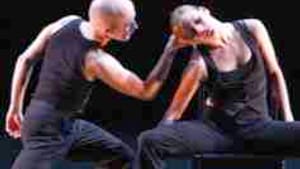Stay in the Loop
BSR publishes on a weekly schedule, with an email newsletter every Wednesday and Thursday morning. There’s no paywall, and subscribing is always free.
Ballet for people who don't particularly like ballet
BalletX's Spring Series (1st review)

Dance brings together the aural and the visual—the only one of the fine arts to do so, aside from opera. Unlike opera, however, dance generally doesn't rely on (sung) language to communicate. Instead, bodies in motion respond to the music and combine with that music to communicate through a language of posture and gesture.
In classical ballet, that language became codified 150 years ago and hasn't been fundamentally reconsidered since. New choreography surfaces, of course, but it recombines the vocabulary of the balletic language— the jeté, the pirouette, the entrechat— in a rigid grammar of acceptable combinations.
This control over the possibilities of movement renders classical ballet a closed system. As such, frankly, it's not terribly interesting to me: It lacks the element of the unexpected, and performances often feel emotionally as well as aesthetically constricted.
Luckily, I'm not alone in wishing there were a way to open up ballet to new movements and new forms of expressiveness. Even more luckily, two people who feel similarly are highly trained dancers (and longtime members of the Pennsylvania Ballet), Christine Cox and Matthew Neenan. They founded BalletX in 2005 and serve as artistic directors of this interesting young company.
They look different, too
At an almost subliminal level, BalletX reveals its nontraditional bent in the makeup of the troupe. The dancers in the spring performance present themselves not as a traditional corps but as individuals: The men range in height from definitely short to fairly tall, and the women wear their hair casually tied back, rather than disciplined into tight chignons.
The real difference, however, is in the expansion of their dance language. Each piece is very firmly rooted in the balletic tradition. Each also adds nontraditional vocabulary in particular gestures (dancers wrapping their arms around themselves) and movements (one dancer slithering around another's knees).
The dances also expand ballet's grammar. For instance, in the final number, Lauren Putty's Hide, the most dramatic lift has a female dancer raised not by one male but by a cluster of four.
Similarly, in Myra Bazell's powerful Carry Me, Christine Cox as the mother lifts the smaller Jennifer Goodman, then Goodman lifts Cox. Those moves, especially the last, wouldn't be found in classical ballet.
Manipulation? Where?
Not all four pieces were equally successful. One Word Play, choreographed by Than Dao, purports to portray "the way we use and manipulate words to construct our identity and power." Perhaps I was distracted by the costumes— the men wore baggy black pants with slit knees, the women one-legged jumpsuits in what looked like '60s upholstery fabric— but I was unable to discern what word, or words, were being manipulated. Despite some interesting moments, the piece as a whole didn't cohere.
Cox choreographed the lighthearted X or Y to a musical mix that begins with Mozart and segues into an electronica tango. There was no deeper philosophical point or underlying story here, just an exploration of movement and music— an exploration that I was happy to follow.♦
To read another review by Janet Anderson, click here.
In classical ballet, that language became codified 150 years ago and hasn't been fundamentally reconsidered since. New choreography surfaces, of course, but it recombines the vocabulary of the balletic language— the jeté, the pirouette, the entrechat— in a rigid grammar of acceptable combinations.
This control over the possibilities of movement renders classical ballet a closed system. As such, frankly, it's not terribly interesting to me: It lacks the element of the unexpected, and performances often feel emotionally as well as aesthetically constricted.
Luckily, I'm not alone in wishing there were a way to open up ballet to new movements and new forms of expressiveness. Even more luckily, two people who feel similarly are highly trained dancers (and longtime members of the Pennsylvania Ballet), Christine Cox and Matthew Neenan. They founded BalletX in 2005 and serve as artistic directors of this interesting young company.
They look different, too
At an almost subliminal level, BalletX reveals its nontraditional bent in the makeup of the troupe. The dancers in the spring performance present themselves not as a traditional corps but as individuals: The men range in height from definitely short to fairly tall, and the women wear their hair casually tied back, rather than disciplined into tight chignons.
The real difference, however, is in the expansion of their dance language. Each piece is very firmly rooted in the balletic tradition. Each also adds nontraditional vocabulary in particular gestures (dancers wrapping their arms around themselves) and movements (one dancer slithering around another's knees).
The dances also expand ballet's grammar. For instance, in the final number, Lauren Putty's Hide, the most dramatic lift has a female dancer raised not by one male but by a cluster of four.
Similarly, in Myra Bazell's powerful Carry Me, Christine Cox as the mother lifts the smaller Jennifer Goodman, then Goodman lifts Cox. Those moves, especially the last, wouldn't be found in classical ballet.
Manipulation? Where?
Not all four pieces were equally successful. One Word Play, choreographed by Than Dao, purports to portray "the way we use and manipulate words to construct our identity and power." Perhaps I was distracted by the costumes— the men wore baggy black pants with slit knees, the women one-legged jumpsuits in what looked like '60s upholstery fabric— but I was unable to discern what word, or words, were being manipulated. Despite some interesting moments, the piece as a whole didn't cohere.
Cox choreographed the lighthearted X or Y to a musical mix that begins with Mozart and segues into an electronica tango. There was no deeper philosophical point or underlying story here, just an exploration of movement and music— an exploration that I was happy to follow.♦
To read another review by Janet Anderson, click here.
What, When, Where
BalletX: Spring Series 2010. Carry Me, by Myra Bazell;
 One Word Play, by Thang Dao;
 Hide, by Lauren Putty;
 X or Y, by Christine Cox. April 14-18, 2010 at Wilma Theater, 265 S., Broad St. (at Spruce). (215) 917-1513 or www.balletx.org.
Sign up for our newsletter
All of the week's new articles, all in one place. Sign up for the free weekly BSR newsletters, and don't miss a conversation.

 Judy Weightman
Judy Weightman